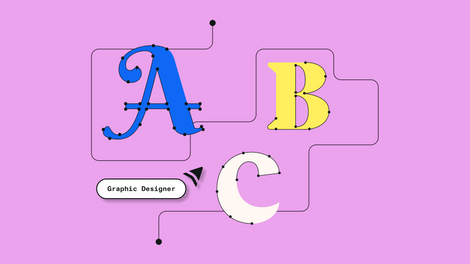The rule of thirds is a technique used for visual composition, traditionally used in design and photography.
When it comes to composing an image, three is the magic number.
With the popularity of iPhones and DIY design software, more people have access to the tools they need to create images and designs than ever before. These tools are creating a new generation of artists who haven’t been classically trained.
Traditionally, professional cameras and graphic design software have been prohibitively expensive and used only by experts. However, the phone cameras and free design platforms that have emerged in the past couple of decades have become more advanced.
In fact, entire movies have been filmed on iPhones. And many businesses are using free or affordable DIY design software to create their own ads and website content.
This accessibility also means that more people are looking for design and composition tips online and are learning how to design and take aesthetically pleasing photos.
You don’t need to go through years of training to be an excellent artist, but beginner photographers and designers should be aware of some classic rules of photography.
That’s where the rule of thirds, and other compositional rules, come into play. We’ll be covering the rule of thirds in this post.
Jumpstart your ideas with Linearity Curve
Take your designs to the next level.
The rule of thirds is a general guiding principle for the best way to compose images.
In this article, we will talk about the history of the rule of thirds, how to use the rule, and when to break it. Plus, we included some excellent examples of artists and photographers using (and breaking) the rule of thirds to help you visualize how you can use this trick.
Let’s jump right into it.
What is the rule of thirds?
The rule of thirds is a compositional rule that suggests aligning your subject within specific guidelines and intersection points.
The rule states that an image should be divided into nine equal parts with four imaginary lines. This involves two horizontal lines and two vertical lines, equally spaced.
Here’s a visual of what the rule of thirds grid looks like.

Some cameras and phones automatically do this, making it easier to follow the rule of thirds when you shoot a photograph. You can also add these lines as an overlay on a piece when you’re first getting started with graphic design.
Using the rule of thirds will generally (but not always) result in better compositions. This rule works for designing ads, creating PowerPoints, taking photographs, and more.
The rule of thirds is really more of a suggestion or guiding principle rather than a hard rule that you should always follow.
And while it’s not a hard and fast rule that can never be broken, it can be an excellent way for beginners to have a place to start. When you’re first getting used to creating art, it can be daunting to know how to get started.
The rule of thirds works well for beginners because it gives them a clear idea of how to shoot their first batch of photos or line up their first design.
Before we talk about how to use it, let’s chat about how the rule of thirds came to be.
History of the rule of thirds
The earliest written account of the rule of thirds in composition was discussed by John Thomas Smith in 1797 in his book Remarks on Rural Scenery.
John Thomas Smith, also known as Antiquity Smith, was a painter and writer in the 18th century. In his book, he mentions the rule of thirds as the best way to break up a photo.
“In connecting or in breaking the various lines of a picture, it would likewise be a good rule to do it, in general, by a similar scheme of proportion” - John Thomas Smith
The key elements of the rule of thirds grid have remained popular in photography and design and are still used today.
Although a bit controversial among artists and not always used in design and photography, it’s a good rule to be aware of for any artist.
Let’s chat about how you can use the rule of thirds for your composition.
How to use the rule of thirds

The rule of thirds will help you create aesthetically pleasing photos and make your work more eye-catching. This is because the rule of thirds plays on how people naturally view images.
The human eye tends to move to certain parts of images, the points of intersection in the rule of thirds. This intersection point is called a power point or a cash point.
This is a perfect visualization of where user attention is most focused and where the best place is to place your focal point in images.
It is recommended to place the horizon on the top or bottom line and line linear features in the image up from section to section. It’s also recommended that major focal points of your composition do not cross the intersection lines.
Placing the subject of your photo or design in the center of an image is considered a static image. The theory behind the rule of thirds posits that with a static image, the viewer’s eye is immediately drawn to it and then left with nothing else to discover.
Get creative with our ready-to-use templates.
Linearity Curve offers templates for every social media platform and various use case templates for posters, business cards, slides, app store screenshots, and more.
Placing your subject along one of the intersection points is a great way to encourage people to explore the image with their eyes. Encouraging interaction will make your photo seem more interesting to the viewer.
It also differs from the amateur photographer’s initial instinct to line up the photo’s subject directly in the center. This is colloquially called the Kodak rule.
When Kodak cameras were released, they encouraged amateur photographers to capture images by telling them to simply line their focal point up in the center of their image and shoot.
Another basic rule of photographic composition to keep in mind is that you should use negative space wisely. Too much can make an image seem stark, and not enough will make an image appear crowded.
However, much like the rule of thirds, you can break these general principles of composition with excellent results.
A lot of negative space could make a design appear minimalist, while no negative space can make a design look maximalist. Both are common design trends this year.
If you become more experienced with photography or design and find that you don’t like to use the rule of thirds, don't worry. We’re about to talk all about how you can break it.
How (and why) to break the rule of thirds
Now that you know how to use the rule of thirds, let’s discuss when and why you might sometimes want to break this rule.
The rule of thirds can be the wrong fit for your photo and designs at times. The rule of thirds is a general rule of thumb that can result in excellent compositions, but it doesn’t always apply.
In fact, many famous photographs have been taken without using the rule of thirds. And many brilliant graphics have been created without obeying the rule as well.
We’ll give some examples below of great photos and designs that don’t follow the rule of thirds.
If you line your subject up in the rule of thirds grid and the photo looks better without using the rule, follow your gut and don’t use it.
After all, rules are meant to be broken.
While Smith might be right about the eye-catching in certain spots of a photo, it doesn’t necessarily mean it’s always the best way to shoot a photograph or create a design.
Some examples of times when the rule of thirds isn’t the best fit for your work include symmetrical images, etc. Also, sometimes your subject is simply too big to fit correctly into the grid.
Now that we’re familiar with the rule of thirds and when to use or break it let's look at some examples of photographers doing it right.
Examples of the rule of thirds
These examples are a perfect visual representation of how great the rule of thirds can make your photos look.
These images will inspire you and hopefully help you realize the difference the grid design can make in your art.
Always use other completion techniques that work well for you in addition to the rule of thirds. The rule of thirds is just one way that you can create a stunning image.
Let’s get started with our first example.
Landscape photography is a perfect example of a great way to employ the rule of thirds.
This landscape image features the horizon perfectly fit into the top third of the picture. The image’s focal point, the message in a bottle, is aligned with the intersection point to the right.
A landscape photo that uses the rule of thirds well is incredibly aesthetically pleasing and exciting to look at.
This is an excellent example of using the rule of thirds in graphic design. Some consider it to be a rule primarily for photography, but it works great for graphic design as well.
The rule of thirds grid in this image perfectly lines up with the flower vase that is the main object of the design. It’s a simple design but still appears more complex because of where the object is placed.
The compositional elements of this work perfectly with the rule of thirds, and lining the main focal point of the image to the side makes it a more exciting design to look at.
The striking bird in this picture is perfectly aligned with the rule of thirds. The main object is lined up on the left side of this image, with the bulk of its body lining up with the vertical line to the left of the center.
The bird’s beak takes up the center square of the grid, but the center composition of this image is not the place that catches your attention.
The subject isn’t dead center, and it works perfectly, forcing your eye to travel around the image to find the focal point. The subject placement was well done and resulted in an eye-catching photo.
The rule of thirds helps lead a viewer's eye where you want it to go, and this picture does that perfectly.
The rule of thirds is perfectly applied to this image in a very creative way. We love the way the figure lines up with the vertical line on the right exactly.
Because the grids are included in these example images, you can see how well they lined their shot up to follow this rule. It’s a great way to visualize how this rule works.
This image has a perfect sense of balance, and the subject matter is incredibly well-placed.
We love the way the rule of thirds compositional technique works in this image.
The perfectly aligned bee and full right side of this image juxtapose the negative space on the left side works perfectly.
The completely empty space on this image emphasizes the fullness and importance of the bee that is the central figure of the composition.
Ready to create brand assets that pack a punch?
Visit our Academy for free rule of thirds courses.
Breaking the rule of thirds examples
As discussed above, you don’t always have to follow the rule of thirds to create beautiful designs.
These designs and photos are created by professional artists without following the rule of thirds. Hopefully, this gives you an idea of what successfully breaking this rule looks like.
If you’re wondering if you can take a brilliant photograph or create a beautiful design without following that rule, here’s some proof that you can.
This is a famous photograph called V-J Day in Times Square, photographed by Alfred Eisenstaedt and published in 1945 in Life Magazine.
Eisenstaedt captioned the photo: "In New York's Times Square a white-clad girl clutches her purse and skirt as an uninhibited sailor plants his lips squarely on hers."
You’ve almost certainly seen this image before, but you likely didn’t consider the rule of thirds when you first saw it. This image is a perfect example of a subject centered directly in the middle of a composition that is still intriguing and interesting to look at
Dunkin Donuts is a classic coffee and donut spot with a renowned design team.
These designers opted to disregard the rule of thirds in creating this well-known ad, and we think it worked out great.
Your eye is still drawn to the photo without the subjects being lined up with the intersection points.
Another famous photo that didn’t follow the rule of thirds but still gained critical acclaim is the Afghan Girl by Photographer Steve McCurry.
The photo is of Sharbat Gula, an Afghan refugee, and was published on the cover of National Geographic in 1985.
Your eye falls immediately on the young woman in the center of the photograph. It’s a beautiful photo and has a great composition without utilizing the rule of thirds.
This image, entitled Migrant Mother, Nipomo, California, by Dorothea Lange, focuses on the woman in the center of the picture.
Lange took this photo during her spell at the Farm Security Administration in 1936.
A static image worked perfectly for the interest of this photo. The main subject is in the center, while the two children are lined up closer to the intersecting points of the picture.
Jamie Reid created this famous design for the well-known band, the Sex Pistols. This image and Reid’s aesthetic shaped the look of the British punk scene during the 1970s and ’80s.
In this image, a black-and-white photo of the queen takes up the center of the design.
This image doesn’t follow the rule of thirds at all but is still a beautiful design that immediately catches your eye.
Wrap up
Now you’re ready to get out there and take perfectly aligned photos and create designs with the best ratio.
Rules in photography and design are meant to help you perfect your art. Use them when you see fit, and ignore them when they aren’t the right thing for what you’re trying to capture.
We know you’ll come up with brilliant ideas.
Try out Linearity Curve (formerly Vectornator) today. Then follow us on social media and tag us in your work; we might even share it on our own social media!
Jumpstart
your ideas with
Linearity Curve
Take your designs to the next level.


Share this!
Lavinia Aparaschivei
Lavinia is a contributing writer to the Linearity Blog.


:quality(75))
:quality(75))



:quality(75))

:quality(75))
:quality(75))



